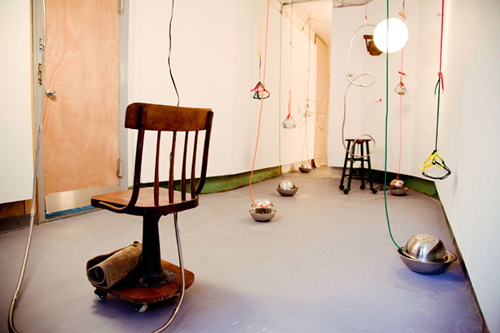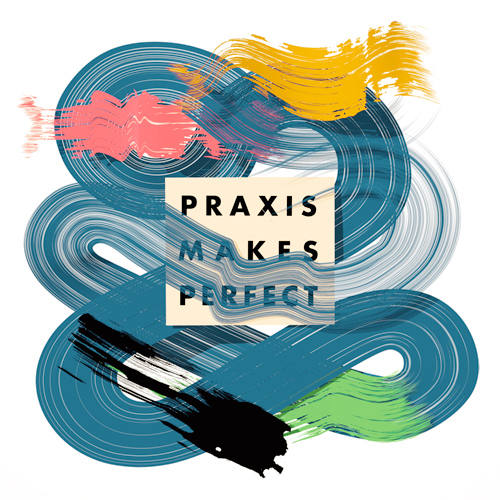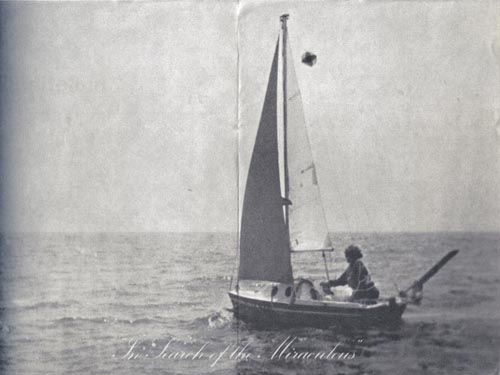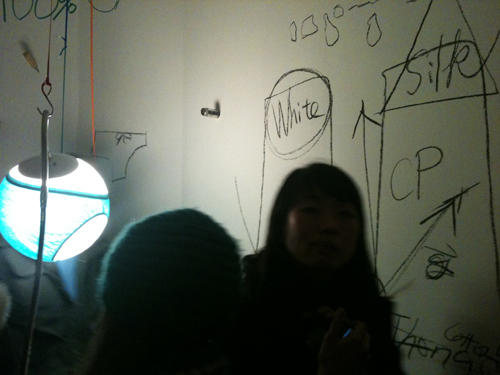Packed into a small gallery in Brooklyn, sound-amplified water drips beside me from an ice block suspended above a pair of stainless steel mixing bowls. I am waiting for the start of Aki Sasamoto’s performance at Soloway Gallery, wondering where she’ll find the space to maneuver in this sea of bodies and hanging sculptures. Suddenly, quietly, the artist appears behind me in a rolling chair.

Aki Sasamoto. “Talking In Circles In Talking” (installation view), 2013, Courtesy of the artist and Take Ninagawa Gallery.
After a few moments of rocking back and forth, Sasamoto ignites the space. Setting a netted ice block in motion along the gallery wall, she uses its wide swinging arc to illustrate the beginning of a quasi-scientific discussion. Amid her reflections on centrifugal force and the physics of motion, she delves into anecdotes about her personal life and past relationships.
Centrifugal force comes from the Latin words centrum, meaning “center,” and fugere, meaning “to flee.” Considering my own trajectory of movement over these past months, I recognize my own existence as a rotating body sent on a series of swinging arcs. In reaching outward to embrace opportunities for creating and exhibiting work, the resulting schedule has felt mad at times. But it has also been an invaluable period of exploration, of movement, of connecting with artists and learning the nuances of place. These months spent traveling have offered a glimpse into the sensation of weightlessness in space.
But the realities of such earthly motion dictate that as far out as we go, we will not fall off the map. At the core of this movement, there is a center that we move from and a force that will pull us back around. Whether our practice is mobile or rooted in one place, this action reveals an important aspect of our development as emerging artists–finding and refining this center of rotation, the places that we come to rely on and move from in both geographic and conceptual terms.
Once upon a time, the world was thought to be a flat disk floating in the ocean. Tall tales exist of Columbus’ sailors threatening mutiny as they came perilously close to what they perceived as the ends of the Earth. The evolution of scientific study has since confirmed that the world is round, and we are both supported by and subject to a gravitational pull. Thinking about this force of gravity as a medium, I am reminded of the work of Dutch-born artist Bas Jan Ader. I discovered Ader’s work during graduate school, pouring over issues of Avalanche magazine in preparation for departmental reading groups. (Avalanche is a now-legendary art periodical that was created in 1970 by Willoughby Sharp and Liza Béar, rigorously documenting the art world’s avant-garde until the end of its run in 1976).
Bas Jan Ader’s small but influential oeuvre of work consists of just a few silent black-and-white films, some photographs, and several performance pieces. But he is a classic cult figure, an artist’s artist revered for the simplicity of his presentation and the purposefulness of his approach. Frailty and vulnerability lie at the heart of much of his work, featuring actions that are both risky and comical in their absurdity. One film depicts Ader falling off a chair–on the roof of his house–and tumbling down its slope to the ground. Another shows him on a bicycle, carefully riding down the street and then suddenly losing his balance and splashing into a canal. The artist didn’t care to talk much about his work publicly; when asked to explain the significance behind the frequent inclusion of such actions, he simply replied, “because gravity overpowers me”.
In the summer of 1975, Ader would perform his final work, In Search of the Miraculous. The day after a choir sang sea shanties in the gallery of his Los Angeles dealer, the 33-year-old artist and experienced sailor said goodbye to his American wife and set out from Cape Cod on a solo voyage across the Atlantic. Sailing in a small boat just over 12 feet in length, his was the smallest craft in which such a feat had ever been attempted. To finish the piece, Ader had planned a second event when he reached the coast of Ireland. Tragically, he never arrived and was declared lost at sea.
Beyond the push and pull of physical motion, there is also an emotional gravity wrapped up in movement. For those leaving the nests of their MFA programs, subsequent decisions often reflect the challenging realities of our (at times, blind) ambition to stake a claim and keep the momentum going. After leaving graduate school, I had my sights set on LA while others opted for New York and beyond. I remember a heartbreaking letter from the time that conjured up images of sailors leaving to explore uncharted seas, unsure of their fate.
In navigating both the struggles and successes of time since, my understanding of what it means to stake a claim has evolved. Moving beyond ideas of location in determining my own center of rotation, this has translated into an increasingly honest process of reckoning. This process does not necessarily require honing in on one place or one discipline, but it does require the willingness to embrace and own the type of practice and sensibility of work we choose to cultivate.
Though it may seem an unlikely comparison, I recognize certain parallels between the works of Aki Sasamoto and Bas Jan Ader. Each artist addresses elemental forces in their conceptual framework, executed in pieces that seem precisely worked out, but at the same time feel unpredictable and out of control (the ambiguity of Ader’s disappearance at sea led to hype that the artist had survived and the event was an orchestrated part of his art). The actions are absurd, but come across as strange and profound. Where they diverge wildly is in their approach: Sasamoto’s vitality and the fight versus Ader’s melancholy and the fall.
Meanwhile, Aki Sasamoto sets another one of her ice blocks in motion, this time swinging the piece directly towards me. Though I maneuver slightly backwards, I am still unable to avoid slowing its motion with a gentle thud. Using these actions as visual aids, she speaks of people who have impacted her life, and in their passing, the objects that now symbolize their lives. Whether scaling the gallery wall or piercing it with screwdrivers as a means of punctuation, she succinctly drives the point home. In the end, what are the things that you want to be defined by? What is the mark that has been made?
Since receiving her MFA from Columbia in 2007, Sasamoto has been on an impressive trajectory. Featured in the 2010 Whitney Biennial and regularly exhibiting work on an international circuit, her energy and ambition are infectious. I think this sentiment is clearly conveyed by the tagline from her website: “Aki Sasamoto is a New York-based, Japanese artist, who works in performance, sculpture, dance, and whatever more medium [sic] that takes to get her ideas across.” Her current exhibition, Talking In Circles In Talking, is up through February 24. You can catch her last performance on February 3 at 7pm.
After seeing her performance, I was left with the impression of an artist with a brave and messy approach, both vulnerable and confident. Reading a 2009 interview in Artforum, I discovered an honest take on Sasamoto’s feelings of the unreal and notions of self-doubt after a series of performances:
“There are two ways of being for me. One is thiis world (the everyday, banal relationships, and talking). The other is thaat world (productions, improvisation, and introspective thinking). There is also a void that occupies the lapse between thiis and thaat. The void sometimes consumes an entire month, and I find it’s interesting enough to pass through many times. In this liminal period I navigate using my smell-like sense, which triggers instant reminders of distant memories and knowledge from other spaces. After enough sniffing of clues, thiis and thaat start to crystallize and inspire curiosity again.”
In considering the forces that move us and bring us back around, it is encouraging to hear others speak to the continuing process of distillation in learning these rhythms of movement and rest. Extending out from our center, we take risks in the pursuit of a more expansive career. Traveling on a swinging arc, we go up, we go big, and we may come down swinging. In the case of Bas Jan Ader’s work, he submitted to these forces and was eventually consumed by them.
Ultimately, the world is not flat, but it’s hard to think of as a perfect sphere. Perhaps it’s more akin to Sasamoto’s mismatched and microphone-equipped stainless steel mixing bowls, two halves of a cacophonous world precariously balanced atop each other. At one point during the performance, someone in the crowd accidentally knocked a hanging cord and a bowl flipped over, the mishap amplified by the microphone inside. It seemed like one half of the world turned upside down, only to be caught by the other. Though unstable and in a constant state of flux, our lives as young artists require the willingness to keep reaching out. It is only by continuing to create the work that we can better understand how it relates to the world around it.







Pingback: Week in Review | 01.26.13 | Art21 Blog